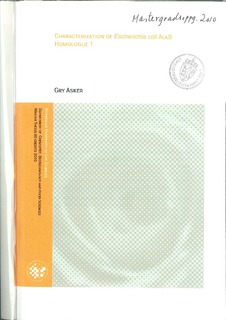| dc.description.abstract | The DNA molecule is exposed to alkylating agents produced endogenously and in the environment. Cells have therefore developed several responses to alkylating damage including direct repair by oxidative demethylation. The Escherichia coli AlkB protein is a Fe(II)- and 2-oxogulatarate dependent oxygenase that demethylates N1-methyladenine and N3-methylcytosine lesion in DNA and RNA.
Eight mammalian AlkB homologues (ALKBH1-8 in humans and Alkbh1-8 in mice) have been identified. The first human AlkB homologue (ALKBH1) has the highest sequence similarity with E. coli AlkB and can partially rescue AlkB deficient E. coli against the methyl methanesulfonate (MMS) alkylating agent. Despite these findings it is not yet confirmed that ALKBH1 can repair DNA in vivo.
Embryonic stem (ES) cells have potential of self-renewal and the ability to develop into any differentiated cell type. A network of transcription factors, including OCT4, NANOG, and SOX2, maintain pluripotency in both human and mouse ES cells. OCT4 and NANOG have been demonstrated to bind the promoter sequence of ALKBH1, thus ALKBH1 might have a role in ES cell self-renewal and pluripotency.
An aim of this study was to identify the biochemical function of ALKBH1 and to characterize a potential role in ES cells. The recombinant ALKBH1 protein was successfully purified, however, its biochemical function could not be determined. Two in vitro protein-protein interaction assays demonstrated that ALKBH1 interacts with core regulators of ES cell pluripotency and with core histones.
In vitro differentiation of mouse ES cells using two different approaches were investigated and Real-time PCR analysis showed that expression of NANOG, OCT4 and SOX2 was down-regulated, whereas the expression of mesoderm and endoderm markers was up-regulated. The expression of Alkbh1 remained nearly constant during differentiation.
Results from this study indicate that ALKBH1 might play a role in ES cell pluripotency, possibly acting as a histone demethylase.
DNA-molekylet utsettes kontinuerlig for skade indusert av endogene og eksogene agens. Disse inkluderer blant annet alkylerende stoffer, som fører til methyleringsskader. For å beskytte mot slike skader har cellene utviklet reparasjonsmekanismer, deriblant direkte demetylering. I Escherichia coli (E. coli) reparerer AlkB proteinet N1-metyladenin og N3-metylcytosin skader i DNA og RNA ved oksidativ demetylering ved bruk av 2-oksogluterat og Fe2+.
I pattedyr er det identifisert åtte AlkB homologer (ALKBH1-8 i mennesker og Alkbh1-8 i mus). Den første humane AlkB homologen (ALKBH1) har høyest sekvenslikhet med E. coli AlkB og kan komplementere metyleringssensitiviteten til AlkB mutert E. coli. Til tross for dette har den enzymatiske aktiviteten til ALKBH1 ennå ikke blitt identifisert.
Embryonale stamceller (ES-celler) er uspesialiserte (pluripotente) celler som har evne til å utvikle seg til alle kroppens over 200 celletyper. Et nettverk av transkripsjonsfaktorer, blant annet NANOG, OCT4 og SOX2, hindrer at ES-cellene begynner å spesialisere seg. Det er tidligere vist at NANOG og OCT4 binder promotorsekvensen til ALKBH1 genet, noe som indikerer at ALKBH1 også kan være med i å opprettholde ES-cellers pluripotens.
Et formål med denne oppgaven var å identifisere den biokjemiske funksjonen til ALKBH1 og karakterisere hvilken rolle enzymet kan ha i ES-celler. Rensing av rekombinant ALKBH1 protein var vellykket, men, i likhet med mange andre, lykkes vi ikke med å påvise biokjemisk aktivitet. To ulike protein:protein interaksjonsassay viste at ALKBH1 interagerer med flere, pluripotensfaktorer og med histoner.
To ulike protokoller for in vitro differensiering av ES-celler ble testet ut, og Real-time PCR viste at ekspresjonen til NANOG, OCT4 og SOX2 ble nedregulert, mens ekspresjonen til mesoderme og endoderme markører ble oppregulert. Uttrykket av ALKBH1 endret seg lite i løpet av differensieringen.
Resultatene fra denne oppgaven indikerer at ALKBH1 kan ha en rolle in ES-cellers pluripotens, muligens ved å fungere som en histon demetylase. | en_US |
